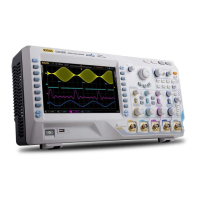Chapter 12 Store and Recall RIGOL
DS4000E User’s Guide 12-3
Storage Type
Press Storage Storage to select the desired storage type. The descriptions of all
types are as follows.
Note: If no USB storage device is currently connected to the instrument, only
“Setups” is available while other items are all grayed and disabled.
1. Traces
Save the waveform data from all the channels currently turned on in external
memory in “*.trc” format. At recall, the data will be displayed on the screen
directly. After recall, when adjusting the settings (such as horizontal scale,
vertical scale, etc.) of the oscilloscope, the waveforms on the screen do not
change accordingly.
Note:
You can only save or recall the "*.trc" files by operation the oscilloscope.
Pressing the CLEAR key can clear the recalled waveforms and the other
waveforms on the screen.
2. Waveforms
Save the main settings (such as the on/off status of the channels, vertical scale,
horizontal scale, etc.) of the oscilloscope and the waveform data from all the
channels currently turned on in external memory in “*.wfm” format. At recall,
the settings of the oscilloscope are set according to the saved information and
the waveform data are displayed. After recall, the oscilloscope is in "STOP"
status. At this point, you can adjust the wavefrom display by adjusting the
horizontal scale, vertical scale, etc. and you can also measure the waveform
parameters by using one-key measurement functions or cursors.
Note:
You can only save or recall the "*.wfm" files by operation the oscilloscope.
If you set the status of the oscilloscope to "RUN", the waveforms data
displayed will be cleared and the oscilloscope will sample new waveform
data.
3. Setups
Save the settings of the oscilloscope in internal or external memory in “*.stp”
format. At most 10 setting files (from LocalSetup0.stp to LocalSetup9.stp) can

